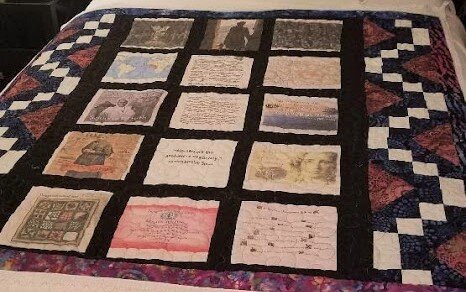WFWP Ohio Underground Railroad Project: Creating Quilts for Peace
“Never give up, for that is the place and time that the tide will turn.” Harriet Beecher Stowe
An image of Mother Moon at Goree Island memorialized on the quilt
In 2018, Dr. Hak Ja Han Moon, the Mother of Peace, visited Goree Island during a conference for peace in Senegal. This place was where thousands of slaves were loaded onto ships, like cargo, never to see their homes again. Many lost their lives on the treacherous sea crossing the Atlantic Ocean. Mother Moon prayed for the liberation of all the tormented souls who perished during the 400 years of slave trade. That prayer ignited a change in how the world perceives the history of slave trade which has currently culminated in an outpouring of tears for current victims of racial hatred.
An excerpt of Mother Moon’s Prayer of Liberation at Goree Island, House of Slaves, on January 19, 2018:
“Christianity did not know Your deep will or Jesus’ essence and they left a sorrowful history here in Africa and on Goree Island. Where did Jesus’ words, “Love your neighbor as yourself” go? The missionaries who came as Christians forgot the essence when they came to Africa. How could they treat people in this way because of differences of skin color? Please remember the people of Africa who have endured and waited for more than five hundred sorrowful years.”
Quilt Square
Racial inequality and slavery has been an issue that was opposed by individuals of all ethnic backgrounds throughout the history of the forming of the Americas. Abolitionists risked their lives and reputations for work they did to speak out and aid slaves in their struggle to become citizens recognized as 100% human. The accepted legal position written into the founding documents of the United States in 1787 stated that slaves were counted as three fifths of a human being for the purpose of congressional representation (even though they were not allowed to vote). This difference of 2/5 has been the issue from the beginning. It is now, in 2020, that these truths have become self-evident.
In recognition of the deep divide that is tearing the USA apart and the importance of the need to restore the 400-year history of slavery, WFWP Ohio created a Freedom Quilt, a project to honor the legacy of women in the Underground Railroad who were the shining beacons of light that created the way to freedom from slavery. The Underground Railroad became the means by which slaves could escape, aided by supporting abolitionists along the way until they reached Canada. One means used to relay messages clandestinely was by using symbols in quilts to mark safe homes and point the way north. The culmination of this project resulted in a quilt for Mother Moon, bringing the 400 years of history that she prayed for together in one American story.
Each of the blocks pieced together in the quilt is a significant part of the Underground Railroad story, with a focus on three women who played key roles in the liberation of slaves during the pre-Civil War era. The central theme focuses on Mother Moon as she stood in the Door of No Return and offered her prayer of liberation for the 400 years of injustice and suffering.
One of the three women of the Underground Railroad that were highlighted was Harriet Beecher Stowe, who was born in the month of June. Below is a brief introduction to her life and work.
Quilt Square – Harriet Beecher Stowe
June 14, 1811 was the birthday of one of the heroines from the abolitionist ranks. Harriet Beecher Stowe is best known for the book she wrote, Uncle Tom’s Cabin or Life Among the Lowly (1850), which inspired many people to join the abolitionist movement. Her firsthand knowledge of the lives of the slaves and the realities of their suffering captured the imaginations of readers in homes throughout the growing United States. The popularity of this book brought Harriet to the White House where Abraham Lincoln gave an award to “the little lady who started the Civil War”.
Harriet came from a prominent family and she was gifted with the ability to write from a young age. Her father, Lyman Beecher, was a Presbyterian minister. Her mother died when she was five years old. Her father remarried to a woman who believed in education for women as well as men. She started a seminary for women which Harriet attended. It was after moving to Cincinatti, Ohio, that Harriet began to see the reality of slavery in nearby Kentucky and witnessed the trials of those who lived in and tried to escape from this indignity.
Harriet became more drawn to the cause of the African slaves, especially the women, after she lost her last baby to cholera, which was raging through the South during those times. She was heart broken and couldn’t stop thinking of the mothers that she had witnessed as their children were auctioned off in front of their eyes.
Multiple landmarks are dedicated in her honor, including the Harriet Beecher Stowe House in Cincinnati that WFWP Ohio members visited last year as one of their stops to educate themselves on the Underground Railroad (read report).




